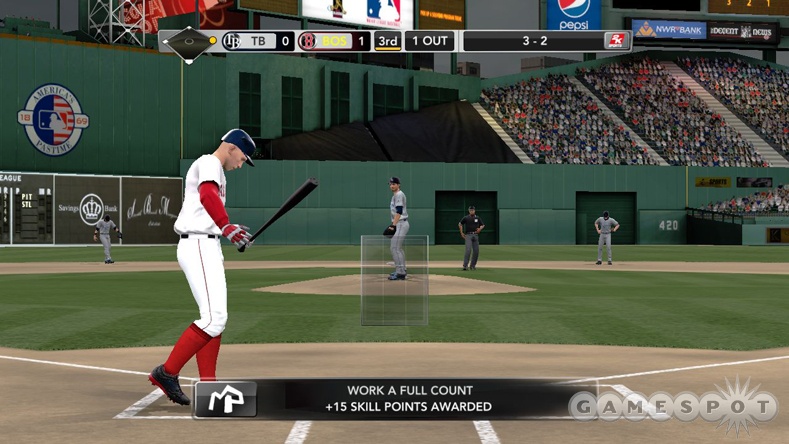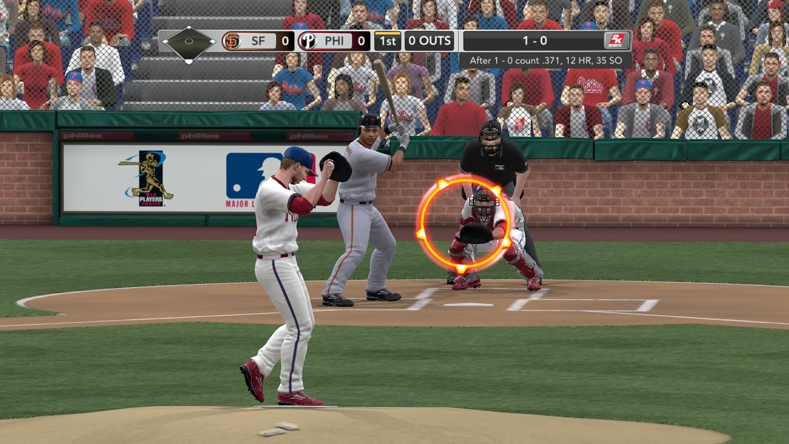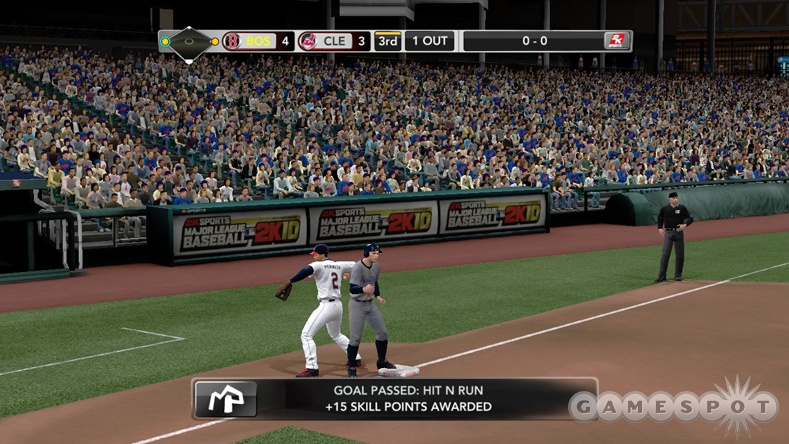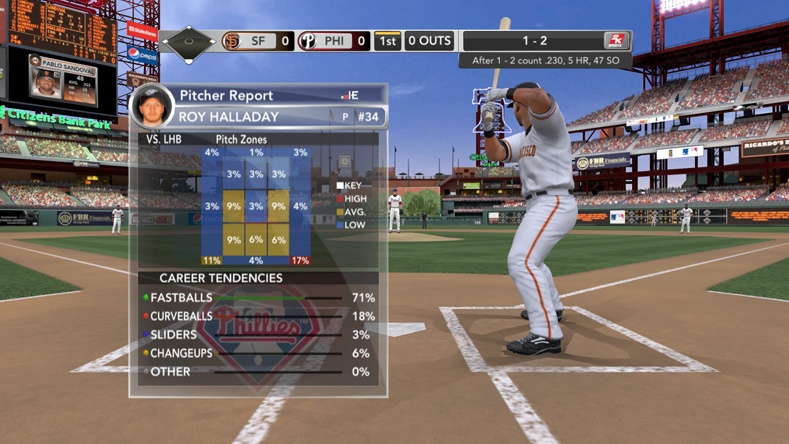If you can't beat 'em, join 'em. Somebody must have scribbled that cheesy old catchphrase on the wall at Visual Concepts sometime in the past year, because the developer has made Major League Baseball 2K10 look and feel a lot like recent entries in the Sony-only MLB: The Show series. Ripping off the competition seems to have been a great idea, too. The result of this copycat-itis is the best game in the decade-long history of 2K Sports' baseball franchise, a more realistic and more fully featured effort that delivers diamond delights in just about every possible way. Gameplay isn't quite as clean as it could be, especially in the new My Player career option that lets you guide a rookie from the minors to the majors. But this is still a great re-creation of the national pastime that stands head, shoulders, and batting helmet above its predecessors.

Where MLB 2K10 most resembles its crosstown rival The Show is in the addition of My Player mode, an option that lets you create a rookie and take him to the bright lights and big cities of the Major Leagues. Those who have played The Show's similarly role-playing-game-flavored Road to the Show will find themselves in familiar territory. You create a rookie phenom, pick a fave franchise to be drafted into, and then set off to try to become an MLB legend. Skill points are awarded just about every time you slip into your spikes. Hit a single, and you get points for hitting. Make a putout or record an assist, and you get points for fielding. Cross home plate with a run, and you get points for baserunning. Strike out the side, and you get points for pitching. And so on. Special objectives and clutch situations provide additional points. You might be called upon to record an out in under five pitches, for example, or work a hit-and-run when standing on first. You take part only in the plays that your player is involved in, which allows you to zip through entire seasons while manually playing nearly every game on the schedule.
How much action you see depends on the position you choose, of course. If you play a pitcher, you're right in there with every toss from the mound, and you can even get called up to the majors after making a measly five starts in AA. If you assume the role of a third baseman, you just take your at-bats and step into the field every now and then to snag liners or catch pop-ups at the hot corner. So it can be a little dull playing a position player, unless you're totally committed. Still, the role-playing aspect is superb, and you'll find yourself feeling a real team vibe, cheering for your buddies when they're at the plate while you're on base, and being satisfied however you contribute to a win. You know you're in a special baseball place when you get a thrill just laying down a bunt to move a runner into scoring position.
Addictive doesn't even begin to describe how compelling My Player can be. Getting hooked is unavoidable if you're any sort of a baseball fan. Games unfold as though you're recording turns in an RPG or a strategy game, so you find yourself stuck playing just one more over and over again as the time flies by. Trying to get your Cooperstown wannabe buffed with the skill points and striving for his success at the plate, in the field, or on the rubber becomes a total compulsion. You can see yourself getting better with every game, improving both manually as you become more adept with the controls and automatically as your skills improve.

That said, My Player is a grind at first for non-pitchers. This is a freshman effort that needs some tweaking. Player progression for anybody who doesn't spend half of a game playing with a rosin bag is a tad tedious. Criteria for being called up to the big leagues is set in stone, so you need to hit targets for things like average, slugging percentage, and games started, as well as reach plateaus in skill ratings such as contact hitting and speed on the basepaths. This presents a problem, because these standards don't account for what sort of player you're trying to build. There is a serious issue with how skill points are awarded to position players for baserunning. For example, to get that phone call from your favorite GM, you need to clock a speed rating of 65, which is all fine and dandy, because Major Leaguers need to move better than the average couch potato. But what if you want to create a lumbering power hitter who might swipe a dozen bases in his career? It's also tough to earn running points no matter what kind of player you're trying to build. Skill points for running are handed out only for things like successfully taking second on hit-and-run plays called by the computer or crossing home plate, all of which is random. It can take a couple of minor league seasons to get up to speed with your running skills, even if you're trying to develop a lead-off Rickey Henderson type.
Another potential issue with My Player is the starting ratings for hitters when it comes to contact and power. Getting good wood on the ball and muscling it into the outfield is not easy during the first two or three years of your career. Rookies are woeful, even for AA ball, with very little pop. You need to time a swing just about perfectly to hit the ball with some authority, and even then your efforts are typically wimpy dribblers that barely make it to an outfielder before dying. If anything, you feel like you're overmatched in the minors, not some future phenom everybody is talking about. Skilled twitch gamers might not have a gripe here. But players who aren't as talented will find themselves either dropping down to rookie difficulty or tweaking the slider settings that determine things like hit power and contact on the default pro difficulty to allow for more oomph at the plate. Neither is a great option, however. Rookie jacks up offense to near-stupid levels (if you don't hit .750 here, check your pulse), and dialing down pro shuts off both achievements and trophies, along with the ability to unlock player cards in games. It would be great to see this issue addressed with a patch that adjusts the initial hitting contact and power ratings in pro. Even a slight boost to power would make things a lot better.
Other aspects of MLB 2K10 are more traditional, yet still greatly improved over last year's edition of the game. The primary modes of play, such as Franchise, Play Now, Home-Run Derby, online ranked matches, and online league play, return largely unchanged. The only significant addition is the MLB Today option that lets you play through the real 2010 Major League season as it takes place, starting with Grapefruit League action. Both the visuals and the audio have been overhauled more thoroughly, at least in the Xbox 360 version of the game. Where MLB 2K9 was flat-out ugly with its wax faces, its 360 successor is finely detailed to the point where you can even see that scruffy wannabe beard sported by Roy Halladay. You can't say the same about the PlayStation 3 take on the game, though. It looks almost unfinished, with jaggies all over the place and lots of noticeable problems with uniforms and shadows. If you have a choice, and visuals are important to you, pick the 360 version of the game. Audio is equally improved on both systems, thankfully. Though their delivery isn't always great, the broadcast-booth trio of Gary Thorne, Steve Phillips, and newbie John Kruk offers real insights into the games being played and baseball as a whole, listing stats like Bill James and even calling created players by name if you've got a moniker reasonably common in North America. Atmospheric sound effects drop you into the middle of a stadium. You even get to enjoy creative jeers and cheers from yahoos in the stands. The only sore point remains the soundtrack, which is all over the place and annoying. Does anyone enjoy hearing Pearl Jam and the Sugarhill Gang back-to-back?

Play on the field has been even more significantly revamped. Much more attention has been paid to realism this year, which shows up in a vastly enhanced pitcher-hitter duel. At-bats are more organic now whether you're on the rubber or in the batter's box. The right-stick pitching interface has been tweaked to provide additional realism and challenge. You now have to really nail pitch motions by twirling the stick accurately (like in last year's game, every pitch type requires you to make a quickie circular motion) and complete the process smoothly to avoid making an odd motion that affects both speed and location. Screw up badly, and you generally wind up throwing a wild pitch into the backstop. Pressure has also been pumped up. If you get into a tough spot against a big hitter or with runners on base, your heart starts pounding as you lose composure. This rumbles through the gamepad and makes it hard to both aim pitches and complete the motions needed to pull them off. It's a superb way to illustrate how tense baseball is on that guy standing all alone on the mound and also brings into play the mental factor so hard to incorporate into baseball games.
At least a mound visit can calm the hurler down. Offensively, everything has been dialed back a fair bit. In place of the slugfests that characterized previous games in the series, now you can work counts and earn walks and even take defensive swings to foul off close ones on the corners. Like real hitters in the big leagues, you have to be patient and wait for your pitch, which is a huge change from the swing-early-and-often philosophy that served you well in the hit-happy earlier games in the MLB 2K line. Of course, hit totals and scores are far more realistic than before, lending games an outstanding sense of authenticity.
A few aspects of gameplay feel off. At the default slider settings, everything in the field is too zippy and frantic when you're out there, which comes as a shock when contrasted with the stoic duel between pitchers and batters. Speed isn't so extreme that you can't make plays, but ball and player movements have been accelerated so that catches and throws often look unrealistic. Weird animations make this effect worse. Players often catch pops contorted like they're doing yoga, and first basemen casually take throws flipping down their gloves instead of stretching properly for the ball. Strange movements take place at the end of innings. If you make an inning-ending catch at third, for example, you often start trotting into right field or do a roundabout jog that looks like an unenthusiastic victory lap. Baserunning is probably the most serious issue. It's just about impossible to steal a base with anyone but the best speedsters in the majors. You have to get off to a perfect jump. Go a split-second early, and you get picked off. Go a split-second late, and you're gunned down by a throw that always seems to be dead on and finished off with a flawless tag. It's immensely frustrating, particularly when you're doing baserunning drills early on with a My Player prospect.

But these problems pale in comparison to issues with online multiplayer. The PS3 version often suffers from just enough lag to make hitting and pitching frustrating, while games on the Xbox 360 generally run smoother but can be difficult to get into. It's entirely possible that you'll manage to get into lag-free games on both systems with little trouble, but at the time of this review experiences like that are definitely the exception rather than the rule.
MLB 2K10 is a very good baseball game that is light years beyond the mess that was MLB 2K9. It needs to be refined in a fair number of areas, which keeps it from knocking the ball out of the park. But the franchise has certainly taken a huge leap forward and sets the stage for next year's game to make a legitimate run for the title.